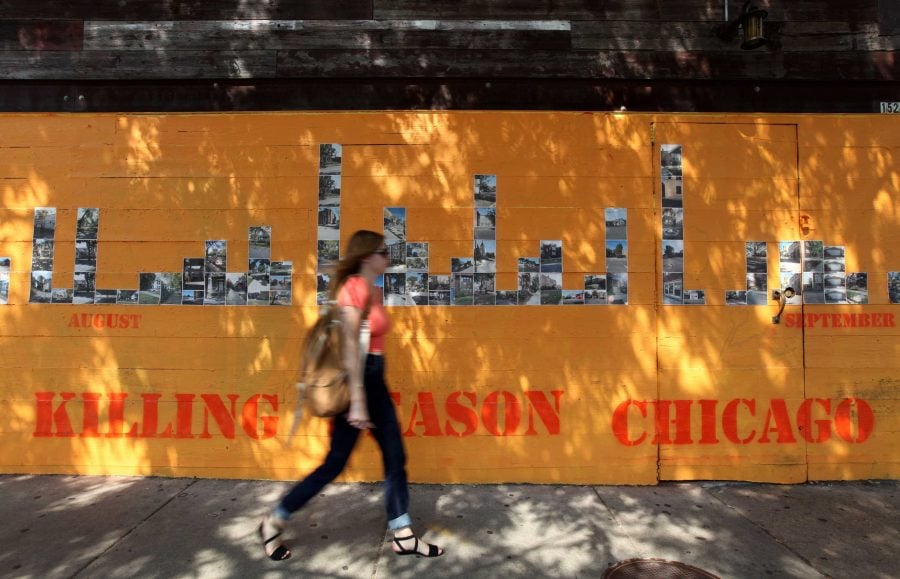So far this year, in the various neighborhoods of Chicago, 440 people have been shot and killed. In 2015, according to DNAInfo’s Chicago Murders timeline, the total number of murders was 493.
Those who survive — a 3-year-old boy who witnessed his grandfather’s murder and attributed it to fireworks, unable to understand what happened, and a 6-year-old girl who returned to riding her bike on the very streets she was shot on — draw organizations and community activists pushing for change locally, while others make the push nationally for increased gun control measures that have largely fallen on deaf ears.
“Some people’s perceptions of gun violence look like ‘The Wire,’” Julia Quinn, of the University of Chicago’s Crime Lab, said. “People think kids are going out, wanting to kill. In homicide narratives here, it is driven by provocations.”
Some of those provocations range from taking a parking spot, to a friendly argument gone awry. Those provocations make up many of the people killed, though drive-by shootings and gang violence also contribute to Chicago’s death rate.
Chicago’s gun violence problem, which has been scrutinized by local and national papers, ties into the larger issue of gun violence and gun control in the U.S., which has come and gone in the national conversation, the ebbs and flows dependent upon the latest shooting.
Mark Walsh, campaign director of the Illinois Council on Handgun Violence, said that 60 percent of the guns in Illinois come from outside of the state, notably Indiana.
Guns are easily bought, sold and traded from person to person. Assault rifles, like the AR-15 used in the Orlando shooting, was easily attained: in Florida, purchasing a gun is as simple as filling out an ID form and paying $8 for a background check. No gun license or gun registration is required.
Once inside the state, guns move freely from owner to owner with no registration or license passed from owner to owner. Those who own guns can modify them — an illegally modified AR-15 was used in the San Bernardino shootings in 2015 — and sell them. The buyer doesn’t need a gun license or registration, creating a record of purchases that is hard, if not impossible, to trace. In this regard, the problems in Chicago, a hub for these guns, mirrors that of other states.
The shootings that have occurred over the course of the summer spotlight this problem, the ease of access to weapons like assault rifles and the inability to track them, as well as the lack of overarching standards to mitigate the problem. Others, notably police-involved shootings, highlight the “militarization” of the police force in largely minority communities.
“One of the problems we see is that because there is no national standard, the states set their own laws,” Walsh said. “Week in and week out we see that it’s easy to access firearms. People on both sides of the issue say ‘why are people allowed to get access to these guns.’”
Walsh also said that there have been more laws passed on the state level than the national level in recent years, something that could be attributed, he said, to the NRA contributions to congressional campaigns.
So far this year, 8,800 people were killed due to gun violence in the U.S. There have been nearly 250 mass shootings and nearly 35,000 gun incidents.
For Chicago, the situation is a bit different. Barry Kellman, director of DePaul’s International Weapons Control Center, said that in regards to mass shootings, “we have to get military grade assault rifles away from people who intend to hurt others.” Kellman, while talking about the city’s gun violence problem as it compares to the rest of the country, noted that the issue was about more than just guns.
Many of Chicago’s neighborhoods are dealing with the effects of long-term blight, or the removal of resources and amenities that are essential to helping a community grow. Crime rates have spiked over the last decade, and even this year. Kellman suggested better policing (not over policing, he said with emphasis), more job opportunities and a “laundry list” of other things.
For Chicago and the nation, the issue to tackle is gun access. Walsh said that connecting both parties behind gun control measures, thereby creating a national standard, could begin to help ease the problems seen in Chicago.
“We need to focus on on keeping guns out of the hands of people who intend to do harm,” Walsh said. “We should monitor the purchasing more closely — bans are unconstitutional, but it’s a regulatable industry. We need to separate the rhetoric from reality.”


